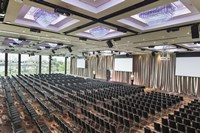Venue & Hospitality
Welcome to the Official Attendee Housing Site for the 7th International Conference on Biodiversity Conservation and Ecosystem Management, scheduled at Melbourne, Australia.
Venue: Mercure Albert Park
Address: 65 Queens Road, Melbourne 3004 – Australia
Conference Dates: July 26-27,2018
Hotel Services & Amenities
- Audio/Visual Equipment Rental.
- Business Center.
- Business Phone Service.
- Complimentary Printing Service.
- Express Mail.
- Fax.
- Meeting Rooms.
- Office Rental.
- Photo Copying Service.
- Secretarial Service.
- Telex.
- Typewriter.
- Video Conference.
- Video Messaging.
- Video Phone.
- ATM.
- Baggage Storage.



Transportation
Driving Directions to
Distance from Melbourne Airport to Mercure Albert Park:
The airport is located just 28.1Km from Mercure Albert Park, which will cost approximately 15USD to 40USD based on the travelling mode.
- One can opt for Taxis and airport shuttles will take approximately 31mins to reach our venue.
- Trams, bus which will cost around 20USD based on the travelling distance; it will take nearly 58mins to reach the hotel through this mode.
- Sky buses are fastest and cheapest mode of transport. Â One can pre-book the tickets through respective website.
Route Map
About City
Melbourne is the state capital and most populous city of the Australian state of Victoria, and the second-most populous city in Australia and Oceania. The name Melbourne covers an urban agglomeration spanning 9,992.5 km, which comprises the broader metropolitan area, as well as being the common name for its city centre. The metropolis is located on the large natural bay of Port Phillip and expands into the hinterlands towards the Dandenong and Macedon mountain ranges, Mornington Peninsula and Yarra Valley. Melbourne consists of 31 municipalities. It has a population of 4,725,316 as of 2016, and its inhabitants are called Melburnians.
Melbourne rates highly in education, entertainment, health care, research and development, tourism and sport, making it the world's most live able city—for the seventh year in a row in 2017, according to the Economist Intelligence Unit. It is a leading financial centre in the Asia-Pacific region, and ranks among the top 15 cities in the world in the Global Financial Centres Index. Referred to as Australia's cultural capital, it is the birthplace of Australian impressionism, Australian Rules football, the Australian film and television industries, and Australian contemporary dance. It is recognized as a UNESCO City of Literature and a major centre for street art, music and theatre. It is home to many of Australia's largest and oldest cultural institutions such as the Melbourne Cricket Ground, the National Gallery of Victoria, the State Library of Victoria and the UNESCO World Heritage-listed Royal Exhibition Building.
Australia is one of seventeen countries described as being 'mega diverse'. This group of countries has less than 10% of the global surface, but support more than 70% of the biological diversity on earth. Australia is home to between 600,000 and 700,000 species, many of which are endemic, that is they are found nowhere else in the world. These include, for example, 84% of our plant species, 83% of mammals, and 45% of birds. Australia's biodiversity - the plants, animals, micro-organisms and their ecosystems - is threatened from the impacts of human activities. Since European settlement, more than 50 species of Australian animals and over 60 species of Australian plants are known to have become extinct.
Australia has more than 1,700 species and ecological communities are known to be threatened and at risk of extinction. Degradation of our environment continues and many ecosystems are increasingly vulnerable to collapse. Australia biodiversity is declining because of the impacts of a range of threats, including: habitat loss, degradation and fragmentation; invasive species; unsustainable use and management of natural resources; changes to the aquatic environment and water flows; changing fire regimes; Climate change.
Lost biodiversity can never be fully recovered, but through our conservation efforts we can help to ensure that species are able to persist and to restore the capacity of ecosystems to adapt to changes and disturbances—in other words, to build ecological resilience.
